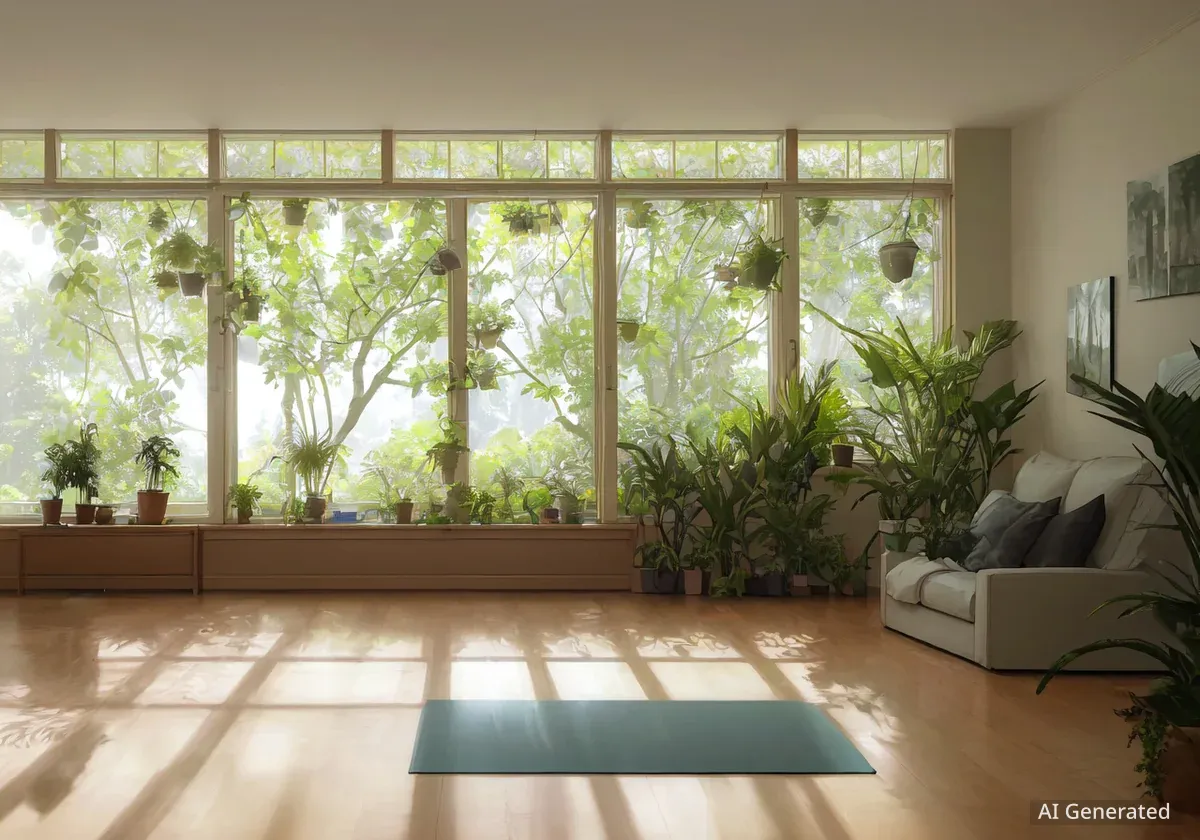A growing number of homebuyers are prioritizing health and well-being in their property searches, leading to a significant shift in the real estate market. Homes and communities designed with wellness in mind are now commanding premium prices, with data showing resale values increasing by 10% to 25%, according to the Global Wellness Institute.
This trend, valued as a $548 billion global sector, reflects a fundamental change in consumer priorities. A nationwide survey indicates that wellness has become the leading motivator for purchasing a home, with many buyers willing to accept smaller living spaces in exchange for features that support a healthier lifestyle.
Key Takeaways
- Wellness is now the top motivator for homebuyers, surpassing traditional factors like square footage.
- Properties designed for well-being are seeing resale value premiums of 10% to 25%.
- The wellness real estate sector is a rapidly growing market valued at over $548 billion globally.
- Key desired features include clean air and water systems, energy efficiency, and access to nature.
- Developers are creating large-scale communities focused on health, sustainability, and social connection.
The Financial Impact of Wellness-Focused Properties
The demand for healthier living environments is not just a social trend; it has clear financial implications for the property market. Data from the Global Wellness Institute highlights a direct correlation between wellness-oriented design and increased property value. Residential properties are not the only ones affected. Commercial buildings with wellness features are also achieving higher returns, securing rental premiums between 4.5% and 7.5% more per square foot.
This market shift is supported by consumer behavior. The America at Home Study, which surveyed 6,000 consumers, found that a significant portion of buyers would trade a larger home or even a garage for a property located in a community that fosters health and social interaction. This indicates a move away from traditional metrics of value, like size, toward lifestyle and well-being.
By the Numbers: The Value of Wellness
- 10% to 25%: Increase in resale value for homes in wellness communities.
- $548 Billion: Current global market size for wellness real estate.
- 4.5% to 7.5%: Rental premium for wellness-focused commercial properties.
These figures demonstrate a strong market validation for real estate that integrates health-centric features.
Defining Wellness in Modern Real Estate
Wellness design extends far beyond adding a gym or walking trail to a development. It involves a holistic approach to creating environments that actively support the physical, mental, and social health of residents. Teri Slavik-Tsuyuki, a co-chair of the Global Wellness Institute’s real estate initiative, explains that the goal is to build wellness into daily routines.
“It means creating homes and communities designed from the ground up that support health and well-being,” Slavik-Tsuyuki stated. This comprehensive strategy focuses on several core pillars.
Core Components of Wellness Design
- Physical Well-being: This includes features that ensure clean air and water, such as whole-house filtration systems, and ample access to natural light. Design that encourages movement is also critical.
- Mental Health: Homes are designed with quiet spaces for relaxation and restorative areas like spa-like bathrooms. The overall layout aims to reduce stress and promote a sense of calm.
- Social Connection: Community planning emphasizes walkable streets, centrally located gathering spots, and layouts that encourage neighborly interaction.
- Sustainability and Resilience: Energy efficiency, the use of sustainable materials, and infrastructure built to withstand severe weather are key components.
Inside the home, this translates to trends like biophilic design, which incorporates natural materials, earth-toned colors, and seamless connections between indoor and outdoor spaces to foster a closer relationship with nature.
What Homebuyers Want Most
Recent survey data provides a clear picture of what features buyers are looking for in a wellness-focused home and community. The America at Home Study identified the top priorities that are influencing purchasing decisions today.
Top In-Home Features
Buyers are focused on health, cost savings, and environmental impact. The most sought-after features inside the home are:
- Modern, well-equipped kitchens for healthy cooking (29%)
- High energy efficiency in insulation, HVAC, and appliances (25%)
- Whole-house water filtration systems for clean water (22%)
- Whole-house air filtration systems for clean air (22%)
- Solar battery storage or a backup power generator (18%)
The Science Behind the Trend
Research cited by the Global Wellness Institute suggests that environmental and lifestyle factors are responsible for 80% to 90% of a person's health outcomes and longevity, far outweighing genetics. Factors like air quality, access to nature, and social opportunities have a direct impact on well-being and can lead to lower rates of chronic disease.
Top Community Amenities
At the community level, buyers prioritize connection to nature and social opportunities. The most desired amenities include:
- Access to nature for outdoor activities (54%)
- Walkability to coffee shops and casual dining (49%)
- An extensive network of trails (48%)
- Small neighborhood parks with seating and shade (45%)
- Large parks and spaces for community events (44%)
Pioneering Wellness Communities in Practice
Several large-scale developments are setting the standard for wellness real estate. These communities serve as models for how to integrate health and sustainability into every aspect of design and planning.
Rancho Mission Viejo, California
Located in Orange County, Rancho Mission Viejo has dedicated 75% of its land to permanent open space for its 14,000 residences. The results are compelling: 83% of residents report that living there has improved their wellness. According to research from the Global Wellness Institute, homes in this community have resale prices that are 12% higher than in comparable nearby areas.
Babcock Ranch, Florida
Babcock Ranch is widely recognized as one of the first master-planned communities in the U.S. built around health and sustainability. Spanning 17,000 acres, it is designed for 22,000 homes and is largely powered by a vast solar energy farm. The community features over 100 miles of trails, integrated schools, parks, and resilient infrastructure designed to withstand major storms.
“The pandemic really put wellness on its jets. Today, when homeowners make a decision about where to live, health and wellness are among their top reasons.”
- Syd Kitson, Developer of Babcock Ranch
Kitson emphasizes that fostering social connection through events like weekly food truck nights and concerts is as important as the physical infrastructure. The town offers a diverse range of housing, from condos to large single-family homes, making the lifestyle accessible at various price points.
As consumer priorities continue to evolve, the real estate industry is responding. The focus on wellness represents what many experts believe is a permanent change in how people choose to live. “There’s a seismic shift ahead in real estate—and it’s our opportunity and obligation to make it happen,” concluded Slavik-Tsuyuki.





